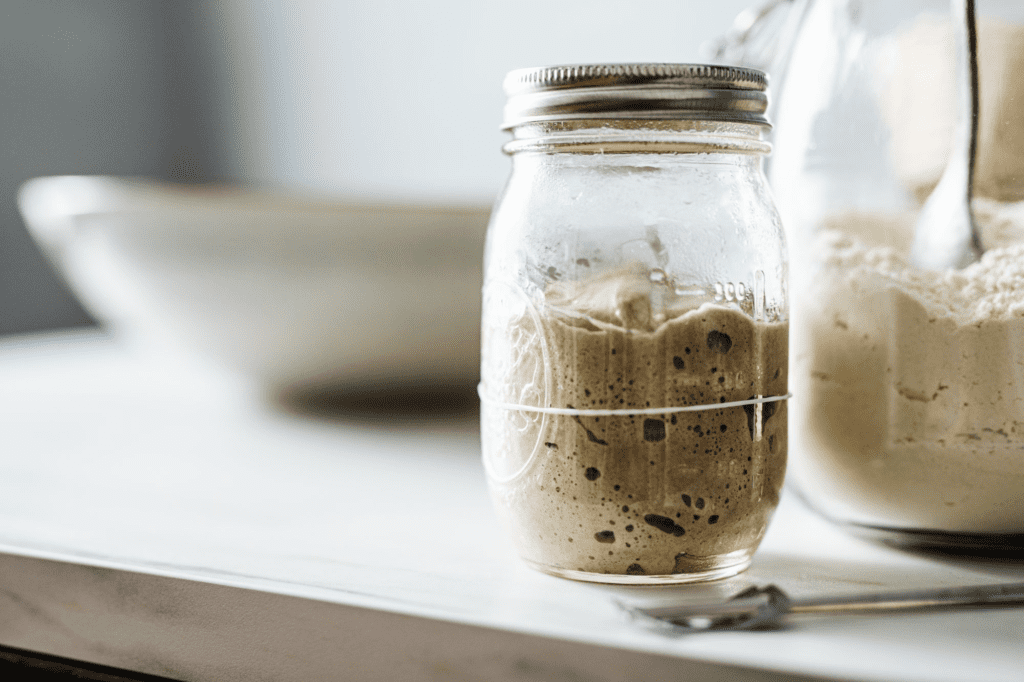
What’s the difference levain vs starter? Making your own sourdough starter can be a tricky process but it can also be a fun and rewarding task.
It’s important to know how to differentiate between levain vs starter as they differ in regards to their ingredients, preparation style and characteristics.
When it comes to creating delicious and airy artisan loaves, many bakers are torn between using levain or starter to achieve the perfect dough.
Generally speaking, both of these methods can do the trick depending on the type of bread you’d like to make, but there are several key differences between them that can affect the final result.
What Is Levain?

Levain is a type of pre-ferment used in French baking; it’s typically comprised of flour, water and acidified liquid yeast cultures.
The recipe for levain is simple: 1 tablespoon of active sourdough starter mixed with 4 tablespoons unbleached all-purpose white flour and 4 tablespoons lukewarm water until smooth.
The resulting mix should be mature (i.e., bubbly) before use; at this point it’s ready to be added when making a loaf of ultra-airy French baguettes.
It also adds depth of flavor—as well as unique nuances—to your baked goods since some strains of wild yeast are believed to have originated centuries ago in France.
What Is Starter?
Starter is made by combining equal parts active sourdough starter with equal parts lukewarm water and unbleached white flour; this mixture will start bubbling as it ferments over several hours before being used in baking recipes such as focaccia or enriched loaves.
Many people consider this form of pre-ferment to be more reliable than levain due to its simplicity and because it requires no special care when stored at cool room temperature until needed.
This is also a great option for bakers who don’t have time for lengthy fermentation processes as it quickly develops sufficient aeration for even large doughs containing whole wheat flours and other ingredients that are often heavy nature.
When compared with levain, starter yields denser results instead of the light sweetness found in bagsuette courtesy from levain fermentation method.
Levain vs Starter: What’s the Difference?
When it comes to making homemade sourdough bread, you may find yourself wondering what the differences are between using levain vs. starter.
These two starters are quite similar, though there are a few key distinctions that set them apart.
Ingredients & Preparation Style
Both types of sourdough starters begin with flour and water, but the difference lies in further ingredient additions; levain traditionally uses extra yeast, while starter does not.
The preparation method for levain is slightly different than that of starter too.
Usually for the first three days, refreshments (adding more water and flour) should take place at 4- to 8-hour.
Intervals whereas with a starter this isn’t necessary until after the first buildup phase is complete and the yeast has become active enough to rise fully between each refreshment period.
Characteristics
The main difference between levain vs. starter is that leaven tends to produce loaves of bread with a more tart flavor due to its fermentation process (which takes anywhere from 3-5 days) being shortened by an added amount of yeast at the beginning stages versus regular starters.
Which take anywhere from 7-10 days before reaching peak activity levels capable of influencing texture or flavor aspects of baked goods.
Resulting in much milder approachable outcomes when compared side by side against leavens final product results.
Conclusion
In conclusion, Levain and Sourdough Starter are both great starters for baking homemade sourdough bread since they both require similar ingredients in order to create successful bakeries!
The key distinction between them lays within their slight differences such as additional yeast usage for Levains, shorter fermentation times (resulting in more tart flavors).
Specific preparation methods – ultimately delivering varying delicious results depending on preference & experimentation!



Leave a Reply